The Arctic Cooling Liquid Freezer II 240 & 420 AIO Coolers Review: Big and Effective
by E. Fylladitakis on January 15, 2021 8:15 AM EST- Posted in
- Cases/Cooling/PSUs
- Corsair
- Water Cooling
- Liquid Cooling
Maximum Fan Speed
Our maximum speed testing is performed with both the fans and the pump of the kit powered via a 12V DC source. This input voltage should have the pump and fans matching the speed ratings of the manufacturer. Arctic Cooling rates the 120 mm fans of the Liquid Freezer II 240 at 1800 RPM and the 140 mm fans of the Liquid Freezer II 420 at 1700 RPM. According to our tachometer, the fans were rotating at 1820 RPM and 1610 RPM respectively, with the 120 mm fans landing very close to their specification but the 140 mm fans were considerably slower than expected, yet still within a reasonable ±10% tolerance.
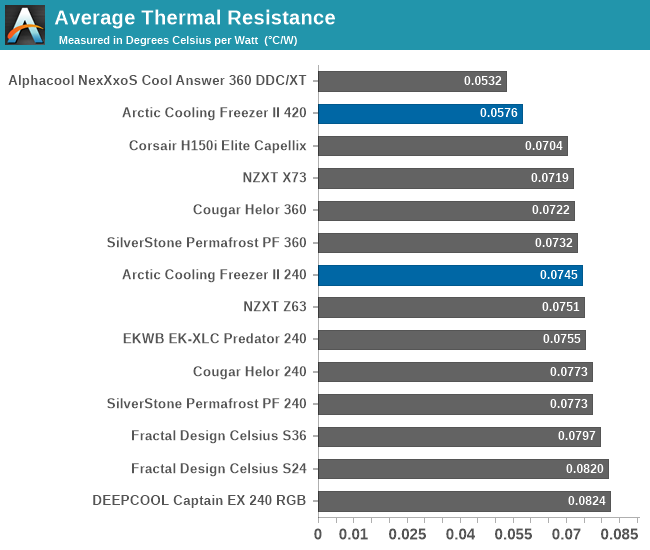
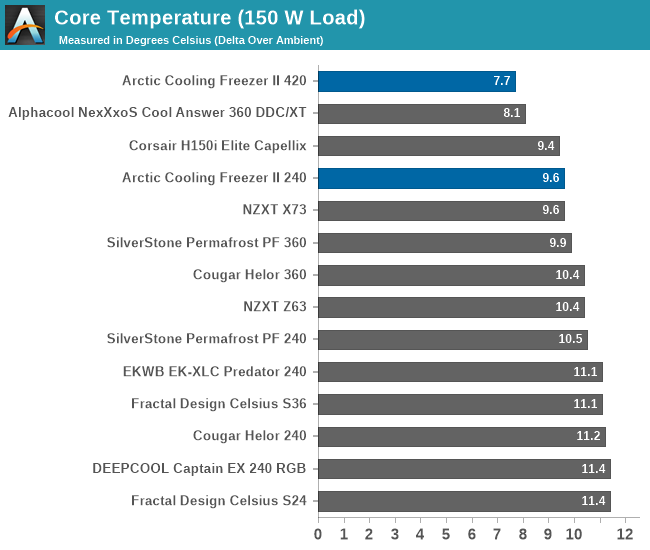
| Core Temperature, Constant Thermal Load (Max Fan Speed) |
At first glance, the average thermal performance charts reveal that the Liquid Freezer II 420 is significantly outperforming any AIO cooler that we have tested to this date. With an average thermal resistance of 0.0576 °C/W, the Liquid Freezer II 420 is exceeded only by a high-end, open loop cooling kit (the Alphacool), and even then it's rather close. One must not forget that the radiator of the Liquid Freezer II 420 also is the largest that we have ever tested, with the design relying on the massive thermal exchange area for its exceptional thermal performance. Still, the flow of the minipump inside the block assembly holds the Liquid Freezer II 420 back, with the advantage of Alphacool’s much more powerful pump being greatly apparent at low loads.
The sound pressure level of the cooler is at 43.8 dB(A), which is on the high side for comfortable use, but to be expected from a cooler using three high speed 140 mm fans.
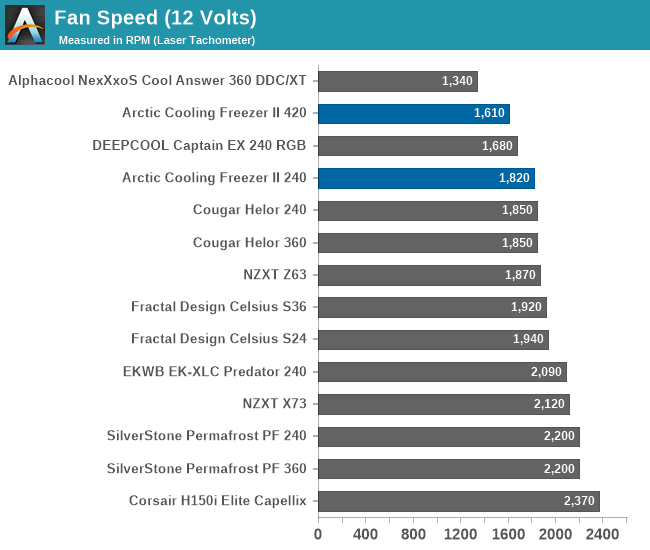
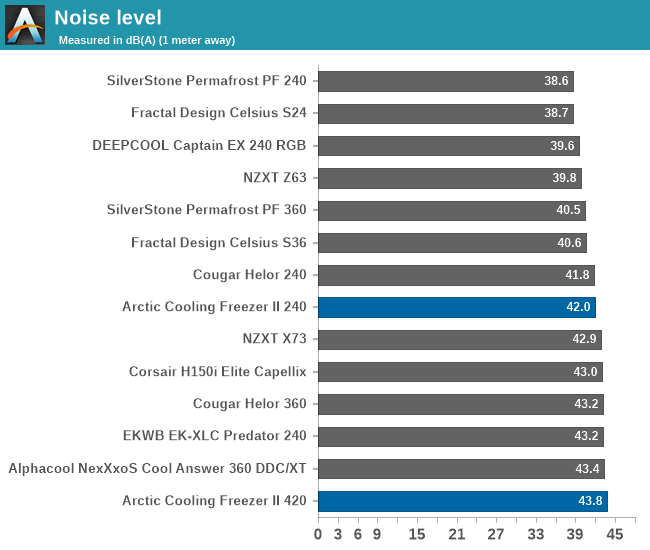
The 240 version of the cooler also performs very well, providing strong competition to equally-sized coolers. The average thermal resistance of the Liquid Freezer II 240 at full fan speeds is 0.0745 °C/W, placing it a tiny bit ahead of most of its direct competitors in terms of thermal performance. However, the sound pressure level of 42 dB(A) is higher than the figures we got from competitive products, with the 40 mm fan on the block mostly responsible for the increased noise output.
Low Fan Speed
Using a PWM voltage regulator, we reduced the speed of the fans manually down to half their rated speed, which is 900 RPM. The pump was also connected to the same power source, functioning properly at this low-speed setting.
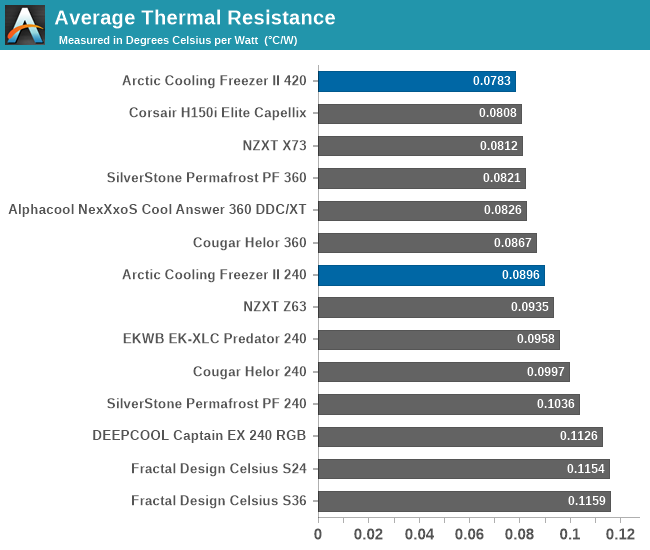

| Core Temperature, Constant Thermal Load (Low Fan Speed) |
The Liquid Freezer II 240 seems to be doing great in this test, with an average thermal resistance of 0.0896 °C/W, surpassing nearly all equally sized AIO coolers. The catch is that it also is significantly louder than its direct competition as well. The emitting sound pressure of 36.7 dB(A) is not high enough to be considered loud, yet the difference over competitive products is significant and discernible.
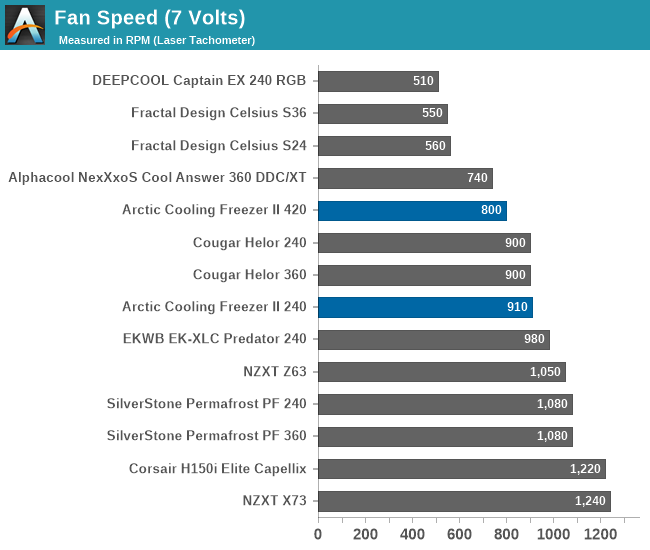
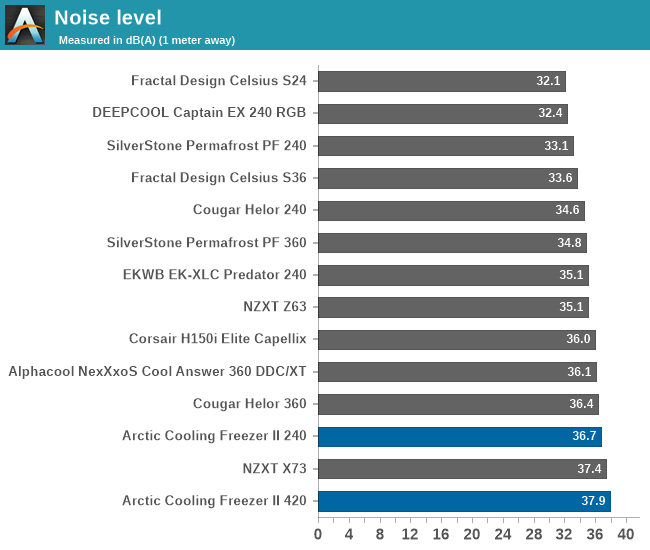
The massive proportions of the Liquid Freezer II 420 give the cooler a great performance advantage even when its fans and pump are at half speed. With an average thermal resistance is 0.0783 °C/W, the Liquid Freezer II 420 thermally outperforms everything that we have ever tested to this date. The sound pressure of 37.9 dB(A) is on the high side though, as expected from three 140 mm fans plus a small 40 mm fan on the main block.
Thermal Resistance VS Sound Pressure Level
During our thermal resistance vs. sound pressure level test, we maintain a steady 100W thermal load and assess the overall performance of the coolers by taking multiple temperature and sound pressure level readings within the operating range of the stock cooling fans. The result is a graph that depicts the absolute thermal resistance of the cooler in comparison to the noise generated. For both the sound pressure level and absolute thermal resistance readings, lower figures are better.
In this graph, we can discern how Arctic Cooling’s liquid coolers rank against the competition at a reasonable power level. We see that the Liquid Freezer II 240 can reach thermal resistance values slightly lower than competitive coolers but can be a bit louder than other designs. Much of that noise is coming from the additional 40 mm fan on the block but the significant backpressure of the thick radiator also is a bit to blame. The thermal performance of the Liquid Freezer II 420 is better than most of the competition but its performance edge is not that great under these operating conditions, as the massive cooler practically requires an equally massive load to reach its optimal operating conditions.


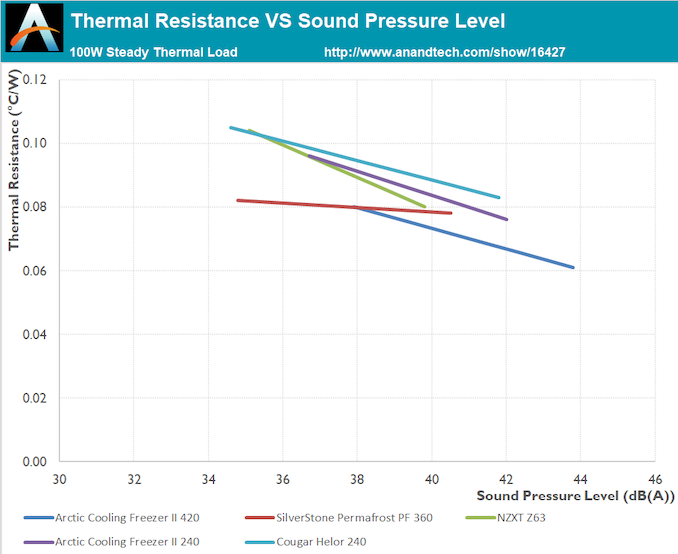








44 Comments
View All Comments
GreenReaper - Saturday, January 23, 2021 - link
You, uh . . . you know that's a bot, right? ^^'Samus - Thursday, January 21, 2021 - link
What kind of case will the 420 even fit in?Tom Sunday - Thursday, March 11, 2021 - link
Nothing new here of significant new tech. Same old same old. Now Arctic jumping on the crowded bandwagon again with just a simple variation of the product. Artic apparently feels that RGB is a waning issue for enthusiasts? They are probably right to think so? Really hope that with all of the "tech-strides" which are happening, that a much more meaningful progress will be forthcoming in the AIO field. With most new generation CPU's are running hotter and hotter, please give me an additional and constant '15-20' degree drop in temps instead of easier assembly options. Looks like that this new 'Artic Freezer' product is not able to serve-up a minus 20 degrees. Other very disappointment issues have been the included fans by most manufacturers and those being second or even third grade. It's a major somewhat hidden money maker for the manufactures to cheapen-out on this but short changing the enthusiast who essentially is their bread and butter.JerseySailor - Thursday, May 27, 2021 - link
Picked up the 280 model. It wouldn't fit my case, and the local Micro-Center didn't have a single one of their dozens of cases that would fit it on top.It came with NO Instructions. After finally finding installation instructions on their web site (look out - they are well hidden and buried deep), I found them to be among the worst installation instructions I've ever seen.
This company needs to clean up its act.